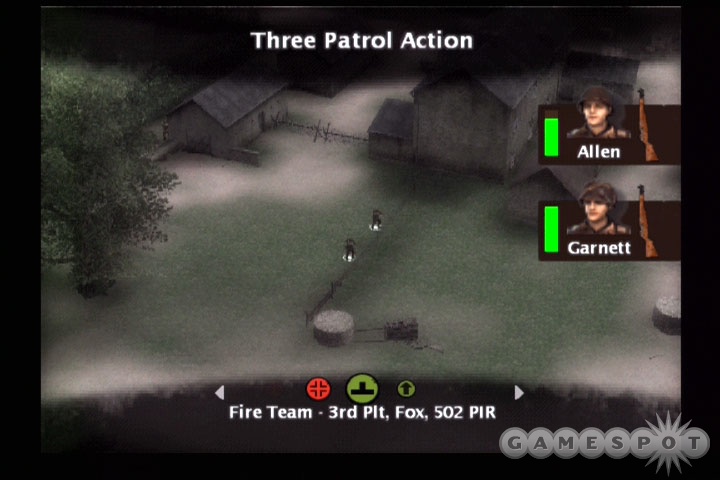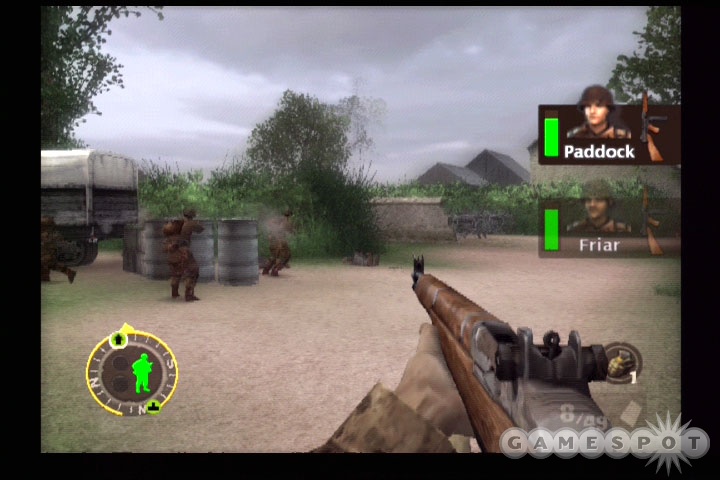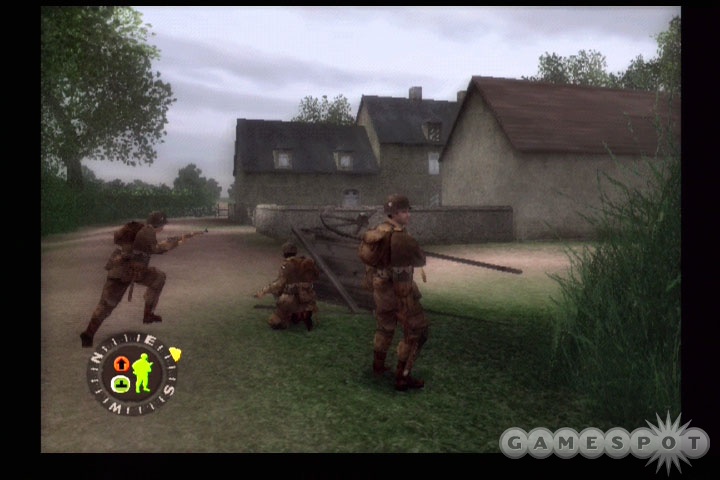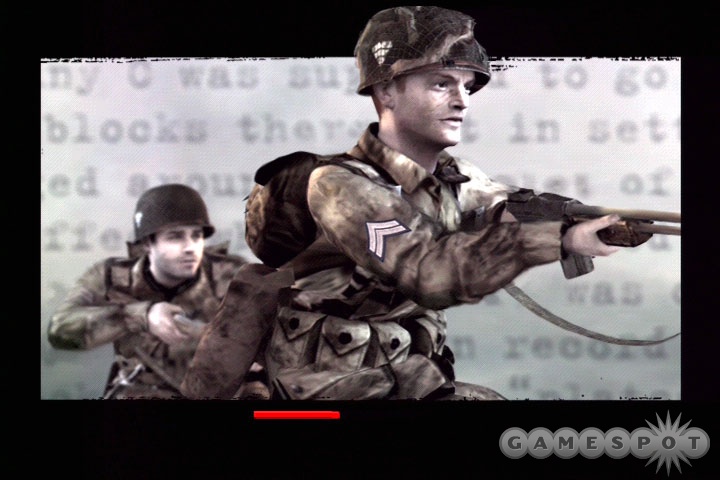When Brothers in Arms: Road to Hill 30 was released earlier this year, it was lauded for its nearly seamless integration between first-person-shooter control and squad command mechanics. While clearly not as twitchy as most shooters, Brothers in Arms focused on the tactical aspect of small-squad infantry combat in World War II and packaged it with a cinema-quality presentation reminiscent of HBO's Band of Brothers. Fewer than seven months later, Gearbox has churned out a sequel. And as you'd expect from a sequel turned around so quickly, Brothers in Arms: Earned in Blood definitely offers a rather similar experience to its predecessor. This is not a good thing, in the case of the PlayStation 2 version, as the shortcomings of the PS2 port of the last game seem to be present in the sequel as well. The novelty of the game's tactical style has also worn off a bit.

For those who aren't familiar with the first game, Earned in Blood puts you in the shoes of an American corporal in World War II named Joe "Red" Hartsock. Hartsock was one of the thousands of US Airborne troopers who dropped in behind enemy lines the night before the Normandy landing in France. The story and the campaign are based on the real-life stories of Hartsock and his mates as they fought across the French countryside in those critical first two weeks after the invasion. For those of you who did play Road to Hill 30, Hartsock's name might ring a bell, and that's because he was a character in the first game. The storyline in Earned in Blood overlaps that of Road to Hill 30, so you'll get to see Hartsock's point of view, as well as his experiences during the same time frame. As you'd imagine, much of the game is played from a flashback perspective as Hartsock is debriefed on his experiences by a superior officer. The in-engine cutscenes used to advance the story before and after missions are as heartfelt and impactful as they were in the first game, with the voice actor depicting Hartsock doing a fantastic job of conveying the emotion you'd expect from a war-weary soldier.
The interface of Earned in Blood is pretty much the same as it was in Road to Hill 30. You play as Hartsock from a first-person perspective and have the ability to walk, kneel, fire, aim down the iron sight of your gun, and throw grenades. You'll also have up to two different fireteams, or one fireteam and a tank, at your command. You can direct each team to follow you, move to an area, open fire on enemies, or charge enemies in an all-out assault. In general, your teammates are intelligent about contextually evaluating their surroundings and finding the proper cover in a given situation. If you direct them near a low wall or log, for example, they'll take up cover behind it. Move them to the side of a building with windows and they'll sidle up between the openings and peer through the windows so they don't leave themselves vulnerable. Once in a while they'll do something stupid, like take themselves out of cover or set up in a bad place. Usually this happens if you plant yourself in the spot you told them to move to. The teammate artificial intelligence in the PlayStation 2 version isn't quite as good as it is in the Xbox and PC versions, because here they'll leave themselves vulnerable more often.

The primary gameplay conceit in Earned in Blood, as in the first game, is to "find, fix, flank, and finish" the enemy. The enemy soldiers you encounter also move in small fireteams. But unlike most other shooters, the enemies in Earned in Blood can be suppressed by firing at their position. Their level of suppression is measured by a red-and-white circle above the enemy position, but these indicators can be shut off for a more realistic experience. Enemies that are suppressed won't fire back as often, and when they do, they're less accurate. The general idea is that you or one of your teams first engages the enemy with a hail of suppressing fire. Then you direct your other squad element (or yourself) around to the side, where you can get a clean shot at the suppressed enemy and can possibly kill him. That's the idea, anyway. One of the huge shortcomings of the PlayStation 2 version of Road to Hill 30 was that the effect of cover for enemies wasn't very pronounced at all. It was very possible to snipe and take down enemies as they came out from behind cover to fire. The same problem still exists in Earned in Blood, and it takes away greatly from what's supposed to be a tactical game at a slow, measured pace. Instead, you'll find that you can play the game much like a regular shooter and just plink away at enemies. But since Earned in Blood's interface and aiming mechanisms don't lend themselves well to a faster sort of shooter, the result is a game that doesn't feel properly balanced.
The AI of the enemy soldiers in the PS2 version of Earned in Blood also leaves something to be desired, especially when measured against the way they play in the Xbox and PC versions, which features an improved AI over the previous game in the series. The enemies in the PS2 version seem to have less regard for their own well-being, as they don't retreat very intelligently from flanking maneuvers and sometimes run right out into the open to get cut down. They also seem to have no qualms about standing up over very low barriers to fire, which leaves them open to get shot, a behavior that is especially dangerous in the PS2 version, as it doesn't take cover into account as much. Also, enemies don't fire very accurately at you. All of this adds up to a game that often feels a lot easier than the PC and Xbox versions, and one that you don't necessarily have to play in such a strategic, tactical manner at all times. You still can't run and gun (the slow nature of the game's movement and aiming interface prevents this), but the bottom line is that something has been lost in translation.
As in the last game, the more than 10 missions in Earned in Blood are called "chapters." These will take you across various parts of France, ranging from farms and forests, to towns and cities and should keep you busy for a little less than 10 hours. The levels feel about the same size as last time, and you're generally compelled to move along a linear path, although there's sometimes more than one angle at which you can approach an enemy or make your way to an objective. The PS2 version feels a little more limited in this respect, though, as level geometry in certain parts of the game has been simplified. Though the novelty of the gameplay mechanics masked the linear nature of the levels in the last game, we found ourselves somewhat disappointed to run into contrived obstacles that kept us from maneuvering as freely as we wanted to in Earned in Blood. The fact that enemies are more apt to retreat or move exacerbates the problem somewhat this time around, as you'll often run into situations where flanking is all but impossible. With an enemy backed into a corner you'll often rely on straight-ahead assaults by your fireteam elements, which are risky, but not quite as much in this version of the game. Grenades are another option, but it's somewhat difficult to aim your tosses in Brothers in Arms, making grenade attacks a trial-and-error affair. Thankfully, the game still offers a number of checkpoints throughout each level, and if you find yourself reloading at the same checkpoint a few times, you'll be offered an opportunity (at lower difficulty levels) to revive your health and the health of your squad members at that point.

There are a couple of new multiplayer options available in Earned in Blood. A skirmish mode lets you play any of the single-player missions cooperatively. Skirmish is available in split-screen mode on a single PS2, or online. Other skirmish modes are available as well, including defense, which requires you to defend wave after wave of enemy troops. Timed assault is another mode that requires you to kill all enemies on a map in a given amount of time. Bonus time is awarded for each enemy you take out, and you're scored based on remaining time. Finally, for the hardcore battlefield tacticians, a very difficult tour-of-duty mode is available, which requires you to complete five consecutive missions with a single squad and a single life. Good luck. Rounding out the multiplayer options is the same objective-based multiplayer mode for two to four players that was available in the last game. There are 20 maps to choose from this time around, and it's pretty much a tactical game of cat and mouse as each player controls his squad and tries to outmaneuver the other team. This mode is as entertaining and challenging as it was the last time, and the new skirmish modes are fun to play with a friend.
Earned in Blood still offers Band of Brothers-esque cutscenes and narration to move the story along, just as in Road to Hill 30. The character and vehicle models are adequately detailed, but the animation in the PS2 version of the game tends to pop. The gore and blood in this version has also been toned down quite a bit compared to the Xbox and PC, although it was never excessive to begin with. There's also noticeably less detail in the environments, but not so much that you'll wonder what you're missing if you've never seen the other versions. At least the sound effects of the different weapons are as sharp and vibrant as ever. There's a lot of voice acting in the game, both during battles as your squadmates shout out to you and each other, as well as during the cutscenes. While the stuff your squad yells in combat can get a bit repetitive, the voice acting in general is excellent, and Hartsock's is especially noteworthy.

It's a shame that the PS2 version of Earned in Blood, like its predecessor, doesn't measure up to the other versions of the game. What's worse is that the reasons are very similar to why the PS2 version of Road to Hill 30 wasn't nearly as good as the Xbox and PC versions. It's as though the lessons learned from the first game haven't been applied here, resulting in an experience that is greatly diminished from what was meant to be. The multiplayer aspects are still pretty solid, but the real draw of Earned in Blood should be its campaign. And while the game is still worth experiencing for the story and cinematics, playing through the campaign in the PS2 version of Earned in Blood ends up feeling a lot less epic than it should.